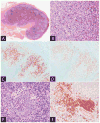Non-neoplastic histiocytic and dendritic cell disorders in lymph nodes
- PMID: 29150219
- PMCID: PMC5803315
- DOI: 10.1053/j.semdp.2017.11.002
Non-neoplastic histiocytic and dendritic cell disorders in lymph nodes
Abstract
Benign and malignant proliferations of histiocytes and dendritic cells may be encountered in lymph nodes. Reactive histiocytic and dendritic cell infiltrates occur in response to diverse stimuli and in addition to causing lymphadenopathy, may be present unexpectedly in lymph nodes excised for other indications. This review summarizes the pathogenesis and histopathological features of the various non-neoplastic histiocytic and dendritic cell infiltrates that can occur in lymph nodes.
Published by Elsevier Inc.
Figures





References
Publication types
MeSH terms
Grants and funding
LinkOut - more resources
Full Text Sources
Other Literature Sources

